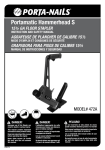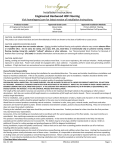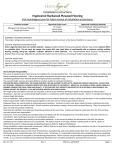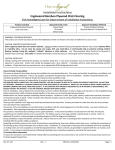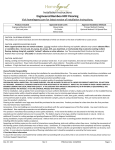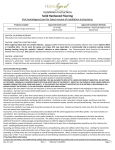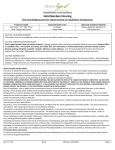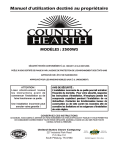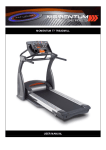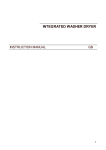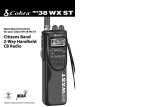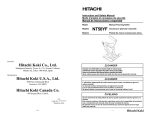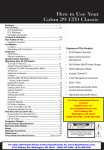Download Porta-Nails 472A Use and Care Manual
Transcript
Instruction and Safety Manual MODEL 472A 15 Gauge Flooring Stapler DANGER Improper use of this Nailer can result in death or serious injury! This Manual contains important information about product safety. Read and understand this Manual before operating the Nailer. Never allow anyone (to handle this tool) who has not reviewed this manual. CONTENTS Page 3 3 IMPORTANT SAFETY INFORMATION DEFINITIONS OF SIGNAL WORDS SAFETY IMPORTANT SAFETY INSTRUCTIONS FOR USING TOOL FLOORING TOOLS EMPLOYER’S RESPONSIBILITIES OPERATION NAME OF PARTS SPECIFICATIONS FASTENER SELECTION ACCESSORIES STANDARD ACCESSORIES OPTIONAL ACCESSORIES BEFORE OPERATION WORKING ENVIRONMENT AIR SUPPLY LUBRICATION COLD WEATHER CARE TESTING THE TOOL ADJUSTING AIR PRESSURE LOADING FASTENERS TOOL OPERATION METHODS OF OPERATION INSTALLING TONGUE AND GROOVE FLOORING 4 9 9 10 11 11 13 13 13 13 13 14 16 16 17 18 19 20 21 23 MAINTENANCE MAINTENANCE AND INSPECTION SERVICE AND REPAIRS EXPLODED VIEW PARTS LISTING 24 26 29 30 2 IMPORTANT SAFETY INFORMATION Read and understand tool labels and all of the operating instructions, safety precautions and warnings in this manual before operating or maintaining this Tool. Failure to follow warnings could result in DEATH or SERIOUS INJURY. Most accidents that result from the operation and maintenance of Tools are caused by the failure to observe basic safety rules and precautions. An accident can often be avoided by recognizing a potentially hazardous situation before it occurs, and by observing appropriate safety procedures. Basic safety precautions are outlined in the “SAFETY” section of this Manual and in the sections which contain the operation and maintenance instructions. Hazards that must be avoided to prevent bodily injury or machine damage are identified by DANGERS and WARNINGS on the Tool and in this DEFINITIONS OF SIGNAL WORDS DANGER indicates an imminently hazardous situation, which if not avoided, will result in death or serious injury. WARNING indicates a potentially hazardous situation, which if not avoided, could result in death or serious injury. CAUTION indicates a potentially hazardous situation, which if not avoided, may result in minor or moderate injury, or may cause machine damage. NOTE emphasizes essential information. 3 SAFETY IMPORTANT SAFETY INSTRUCTIONS FOR USING TOOLS READ ALL INSTRUCTIONS DANGER 1. OPERATORS AND OTHERS IN WORK AREA MUST WEAR SAFETY GLASSES WITH SIDE SHIELDS. When operating the Tool, always wear eye Safety glasses with side shields, and make Sure others in the work area wear safety Glasses, also. Safety glasses must conform to the requirements of American National Standards Institute, ANSI Z87.1 and provide protection against flying particles both from the front and side. The employer must enforce the use of safety glasses by the Tool operator and others in work area. 2. NEVER USE OXYGEN OR OTHER BOTTLED GASES. EXPLOSION MAY OCCUR. Never use oxygen, combustible gases or any other bottled gases as a power source for the Tool. Use of the above gases is dangerous, as the Tool will explode. Use only clean, dry, regulated compressed air. WARNING 3. NEVER POINT TOOL AT YOURSELF OR OTHERS IN WORK AREA. Always assume the Tool contains fasteners. Never point the Tool at yourself, toward yourself or others whether it contains fasteners or not. If fasteners are mistakenly driven, it can lead to severe njuries. Never engage in horseplay with THE Tool. Respect the tool as a working implement. 4 SAFETY-CONTINUED WARNING 4. KEEP FINGERS AWAY FROM TRIGGER WHEN NOT DRIVING FASTENERS TO AVOID ACCIDENTAL OPERATION. Never carry the Tool with finger on safety trigger since you could drive a fastener unintentionally and injure yourself or someone else. Always carry the Tool by the handle only. 5. CHOICE OF TRIGGERING METHOD IS IMPORTANT. Please read and understand page 21 of “METHODS OF OPERATION.” 6. DO NOT EXCEED 90 psi. (6.2 bar 6.3 kgf/cm2) Do not exceed maximum recommended air pressure 90 psi (6.2 bar 6.3 kgf/cm2). 90psi 200psi Never connect the Tool to pressure which potentially exceeds 200 psi (13.7 bar 14 kgf/cm2) as the Tool can burst. 7. ALWAYS WEAR EAR AND HEAD PROTECTION. Always wear ear protection to protect your ears from loud noise. Always wear head protection conforming to ANSI Z89.1-1986 to protect your head from flying objects. 8. STORE TOOL PROPERLY. When not in use, the Tool should be stored in a dry place. Keep out of reach of children. Lock the storage area. 9. KEEP WORK AREA CLEAN. Cluttered areas invite injuries. Clear all work areas of unnecessary tools, debris, furniture, etc. 10. NEVER USE IN PRESENCE OF FLAMMABLE LIQUIDS OR GASES. The Tool produces sparks during operation. Never use the Tool in sites containing lacquer, paint, benzine, thinner, gasoline, gases, adhesive agents, and other materials which are combustible or explosive. 5 SAFETY-CONTINUED WARNING 11. KEEP VISITORS AWAY. Do not let visitors handle the Tool. All visitors should be kept away from work area. 12. DRESS PROPERLY. Do not wear loose clothing or jewelry as they can be caught in moving parts. Rubber gloves and nonskid footwear are recommended when working indoors. Wear protective hair covering to contain long hair. 13. NEVER USE NON RELIEVING COUPLER ON TOOL. If a non relieving coupler is used on the Tool, the Tool can remain charged with air after disconnecting and thus will be able to drive a fastener even after disconnecting. The Tool and air hose must have a hose coupling such that all pressure is removed from the Tool when the coupling joint is disconnected. 14. CHECK SAFETY BEFORE USE. Make sure the safety trigger operates properly. Never use the Tool unless the safety trigger is operating properly, otherwise the Tool could drive a fastener unexpectedly. Do not tamper with or remove the safety trigger, otherwise the safety trigger becomes inoperable. 15. KEEP ALL SCREWS AND COVERS TIGHTLY IN PLACE. Keep all screws and covers tightly mounted. Check their condition periodically. Never use the Tool if parts are missing or damaged. 16. DO NOT LOAD FASTENERS WHILE RAM CAP IS CONTACTED OR SAFETY TRIGGER IS OPERATED. When loading fasteners into the Tool or when connecting the air hose, 1) Do not contact the ram cap. 2) Do not depress the safety trigger; and 3) Keep the Tool pointed downward. 17. KEEP FACE, HANDS AND FEET AWAY FROM DISCHARGE AREA DURING USE. Never place your face, hands or feet closer than 8 inches (200 mm) from discharge area. A serious injury can result if the fasteners are deflected by the work piece, or are driven away from the point of entry. 6 SAFETY—CONTINUED WARNING 18. PLACE TOOL PROPERLY ON WORK PIECE. Do not drive fasteners on top of other fasteners or with the Tool at too steep of an angle; the fasteners can ricochet and hurt someone. 19. BE CAREFUL OF DOUBLE FIRE DUE TO RECOIL. Keep face, hands and body away from the discharge area of the tool. The tool may bounce from the recoil of driving a fastener and an unwanted second fastener may be driven possibly causing injury. 20. DO NOT DRIVE FASTENERS INTO THIN BOARDS OR NEAR CORNERS AND EDGES OF WORK PIECE. The fasteners can be driven through or away from the work piece and hit someone. 21. NEVER DRIVE FASTENERS FROM BOTH SIDES OF A WALL AT THE SAME TIME. The fasteners can be driven into and through the wall and hit a person on the opposite side. 22. CHECK FOR LIVE WIRES. Avoid the risk of severe electrical shock by checking for live electrical wires that may be hidden by walls, floors or ceilings. Turn off the breaker switch to ensure there are no live wires. 23. NEVER CARRY TOOL BY HOSE. 24. DO NOT OVER REACH. Keep proper footing and balance at all times. 25. NEVER USE TOOL WHICH IS DEFECTIVE OR OPERATING ABNORMALLY. If the Tool appears to be operating unusually, making strange noises, or otherwise appears defective, stop using it immediately and arrange for repairs by a PNI authorized service center. 26. DO NOT DISCONNECT AIR HOSE FROM TOOL WITH FINGER ON TRIGGER. The Tool can operate when re-connected to an air supply. 7 SAFETY—CONTINUE WARNING 27. DISCONNECT AIR HOSE FROM TOOL WHEN: 1) Doing maintenance and inspection; 2) Loading fasteners; 3) Clearing a jam; 4) It is not in use; 5) Leaving work area; 6) Moving it to another location; and 7) Handing it to another person. Never attempt to clear a jam or repair the Tool unless you have disconnected air hose from the Tool and removed all remaining fasteners from the Tool. The Tool should never be left unattended since people who are not familiar with the Tool might handle it and injure themselves. 28. STAY ALERT. Watch what you are doing. Use common sense. Do not operate the Tool when you are tired. The Tool should never be used by you if you are under the influence of alcohol, drugs or medication that makes you drowsy. 29. HANDLE TOOL CORRECTLY. Operate the Tool according to the Manual. Never allow the Tool to be operated by children, individuals unfamiliar with its operation or unauthorized personnel. 30. NEVER USE TOOL FOR APPLICATIONS OTHER THAN THOSE SPECIFIED IN THIS MANUAL. 31. HANDLE TOOL CAREFULLY. Because of high air pressure in the Tool, cracks in the surface are dangerous. To avoid this, do not drop the Tool or strike the Tool against hard surfaces; and do not scratch or engrave signs on the Tool. Handle the Tool carefully. 32. MAINTAIN TOOL WITH CARE. Keep the Tool clean and lubricated for better and safer performance. 33. USE ONLY PARTS, ACCESSORIES OR FASTENERS SUPPLIED OR RECOMMENDED BY PNI. Unauthorized parts, accessories, or fasteners may void your warranty and can lead to malfunction and resulting injuries. Only service personnel trained by PNI, distributor or employer shall repair the Tool. 8 SAFETY—CONTINUED WARNING 34. NEVER MODIFY OR ALTER A TOOL. Doing so may cause it to malfunction and personal injuries may result. IMPORTANT SAFETY INSTRUCTIONS FOR USING Model 472A FLOORING TOOL WARNING 1. NEVER use a hammer with a loose head or splintered handle. 2. Do not tie, tape, or otherwise disable the safety trigger as this could result in accidental discharge of the Tool causing injury to yourself and others. 3. Do not strike the ram/actuator without pulling the safety trigger. Hitting the Tool with the safety interlock engaged will severely damage the safety mechanism and the Tool. This abuse and damage is not covered by the warranty. EMPLOYER’S RESPONSIBILITIES 1. Ensure that this MANUAL is available to operators and personnel performing maintenance. 2. Ensure that Tools are used only when operators and others in work area are wearing EYE PROTECTION. 3. Enforce the use of EYE PROTECTION by operators and others in work area. 4. Keep Tools in safe working order. 5. Maintain Tools properly. 6. Ensure that Tools which require repair are not further used before repair. SAVE THIS MANUAL AND KEEP IT AVAILABLE FOR OTHERS! 9 OPERATION Note: The information contained in this Manual is designed to assist you in the safe operation of the Tool. Some illustrations in this Manual may show details or attachments that differ from those on your own Tool. NAME OF PARTS HANDLE SAFETY PLATE RAM CAP PLUNGER SAFETY TRIGGER BODY POPPET MALE AIR SWIVEL FITTING PISTON LOCK NUT DRIVER BLADE PISTON CUSHION SHOE SHOE BASE (REVERSABLE) MAGAZINE 10 SPECIFICATIONS MODEL 472A Operating Pressure 70-90psi (4.8-6.2 bar 4.9-6.3 kgf/cm²) Actuation Hammer Actuate with Safety Interlock Dimensions Length x Width x Hieght 18” x 22-3/4” x 3-1/8” (457mm x 481mm x 79mm) Weight 9 lbs (4.1 kg) Staple Capacity 150 Staples Air Consumption .058 ft³/cycle @ 80psi (1.64 ltr/cycle @ 5.5 bar) (1.64 ltr/cycle @ 5.6 kgf/cm²) Air Inlet 3/8” NPT Thread FASTENER SELECTION Only fasteners shown in the table below can be driver with this tool. WARNING Be sure to use only genuine PNI Staples for the 472A. The use of any other fasteners can result in tool malfunction and/or fastener breakdown, leading to serious injury. Dimensions of Staples 15 GAUGE STAPLE MIN. 1-1/2” (38mm) 11 MAX 2” (50mm) The 472A Pneumatic Flooring Stapler, with the standard shoe, drives 1-1/2” and the 2” 15ga staples into the tongue and groove flooring at a 45 degree angle. The orientation of the fastener is as depicted above. To convert from 3/4” flooring to 1/2” flooring simply (loosen and remove shoe pad screws x3 ) and reverse the shoe pad of the nailer shoe. Loosen Shoe Pad screws and rotate Shoe Pad 180° for nailing 1/2” flooring Note: The end of the pad is marked with 3/4” and 1/2” indicating the correct flooring application. Fastener Application Chart FASTENER 2” 15ga. Staple APPLICATION T&G FLOORING THICKNESS Angle staple onto 5/8” - 3/4” underlayment over joist construction 3/8”, 1/2”, 9/16”, 5/8” 3/4”, 33/32” Surface (face) nail onto 5/8” - 3/4” underlayment over joist construction 1-1/2” 15ga. Staple Angle staple onto 5/8” - 3/4” underlayment over concrete slab or hydronic coil heating systems 3/4”,33/32” Surface (face) nail onto 3/4” underlayment over concrete slab or hydornic coil heating systems 5/8” - 33/32” 12 ACCESSORIES WARNING Accessories other than those shown below can lead to malfunction and resulting injuries. STANDARD ACCESSORIES OPTIONAL ACCESSORIES 1. Hammer 2. Wrench Set (Service Parts Kit) 3. Safety Glasses 4. Carrying Case 5. Pneumatic Tool Lubricant 1. 9/16” - 3/4” Pre-finished (wide profile) Flooring Shoe ( Code No. 47395) 2. Floor tightening and straightening Jack (Code No. 47100) AVAILABLE STAPLES 1. 2. 3. 4. 1-1/2” 15ga. Staple (Code No. 47271) (1M/Pack) 5. 2” 15ga Staples (Code No. 47281) (Stainless) (1M/Pack) 1-1/2” 15ga. Staple (Code No. 4724) (5M/Pack) 6. 2” 15ga, Staples (Code No. 4725) (Stainless) (5M/Pack) 2” 15ga. Staple (Code No. 447261) ( 1M/Pack ) 2” 15ga. Staples (Code No. 4722) (5M/Pack) Note: Accessories are subject to change without any obligation on the part of PNI. APPLICATIONS For installation of 1/2”, 5/8” and 3/4”tongue and groove solid wood and engineered hardwood flooring. BEFORE OPERATION Read over section titled “SAFETY” (pages 4-9). Make sure of the following before operation. WORKING ENVIRONMENT WARNING • No flammable gas, liquid or other flammable objects at worksite. • Clear the area of children or unauthorized personnel. 13 AIR SUPPLY DANGER • NEVER use oxygen or other bottled gases. Explosion may occur. WARNING • Never connect Tool to pressure which potentially exceeds 200 psi (13.7 bar 14 kgf/cm2). • Never use non relieving coupler on Tool. 1. Power Source • Use only clean, dry, regulated compressed air as a power source for this Tool • Air compressors used to supply compressed air to this Tool must comply with the requirements of the latest version of ANSI Standard B 19.3 “Safety Standard For Compressors For Process Industries.” • Moisture or oil in the air compressor may accelerate wear and corrosion in the Tool. Drain daily. • Air volume is as important as air pressure. The air volume supplied to the tool may be inadequate because of undersized fittings and hoses or from the effects of dirt and water in the system. Restricted air flow will prevent the tool from receiving an adequate volume of air, even though the pressure reading is high. The results will be slow operation, jamming, miss-feeds or reduced driving power. Before evaluating tool problems for these symptoms, trace the air supply from the tool to the supply source for restrictive connectors, swivel fittings, low points containing water and anything else that would prevent full volume flow of air to the tool. 2. Filter-Regulator-Lubricator • A pressure regulator with an operating pressure of 0-125 psi (0-8.6 bar 0-8.8 kgf/cm2) is required to control the operating pressure for safe operation of this Tool. Do not connect this Tool to air pressure which can potentially exceed 200 psi as Tool may fracture or burst, possibly causing injury. • Filter-Regulator-Lubricator units supply an optimum condition for the Tool and extend the Tool life. 14 These units should always be used Filter............... The filter removes moisture and dirt mixed in compressed air. Drain daily unless fitted with an automatic drain. Keep the filter clean by regular maintenance. Regulator....... The regulator controls the operating pressure for safe operation of the Tool. inspect the regulator before operation to be sure it operates properly. Lubricator...... The lubricator supplies an oil mist to the Tool. Inspect the lubricator before operation to be sure the supply of lubricant is adequate. Use PNI pneumatic tool lubricant. Regulator Stapler side Compressor side Filter Lubricator 3. Air Hose Air hoses should have a minimum of 150 psi (10.4 bar 10.6 kgf/cm2) working pressure rating or 150 percent of the maximum pressure that could be produced in the air system. The supply hose should contain a fitting that will provide “quick disconnecting” from the male plug on the Tool. 4. Hose Coupling Install a male plug on the Tool which is free flowing and which will release air pressure from the Tool when disconnected from the supply source. This Tool uses a 3/8” NPT. male plug. The inside diameter should be .275” (7mm) or larger. The fitting must be capable of discharging Tool air pressure when disconnected from the air supply. 5. Air Consumption The Tool requires 4.2 cfm of free air to operate at the rate of 60 fasteners per minute @ 80 psi. Take the actual rate at which the Tool will be run to determine the amount of air required. For instance, if your fastener usage averages 30 fasteners per minute, you need 50% of the Tools cfm. 6. Operating Pressure 70 to 90 psi. Select the operating pressure within this range for best fastener performance. DO NOT EXCEED THIS RECOMMENDED OPERATING PRESSURE. 15 LUBRICATION Frequent, but not excessive, lubrication is required for best performance. Oil added through the air line connection will lubricate the internal parts. Use Pneumatic Tool Lubricant, Mobil Velocite #10, or equivalent. Do not use detergent oil or additives as these lubricants will cause accelerated wear to the seals and Piston Cushion in the Tool, resulting in poor tool performance and frequent Tool maintenance. If no airline lubricator is used, add oil during use into the air fitting on the Tool once or twice a day. Only a few drops of oil at a time are necessary. Too much oil will only collect inside the Tool and will be noticeable in the exhaust cycle. COLD WEATHER CARE For cold weather operation, near and below freezing, the moisture in the air line may freeze and prevent Tool operation. We recommend the use of WINTER FORMULA air tool lubricant (NEW-MATIC Winter Formula or equivalent) or permanent anti freeze (ethylene glycol) as a cold weather lubricant. CAUTION Do not store tools in a cold weather environment to prevent frost or ice formation on the tools operating valves and mechanisms that could cause tool failure. NOTE: Some commercial air line drying liquids are harmful to O-rings and seals – do not use these low temperature air dryers without checking compatibility. CAUTION Do not operate the Tool at high pressure without fasteners 16 TESTING THE TOOL WARNING • Operators and others in work area MUST wear safety glasses with side shields which conforms to ANSI Z87.1 specifications. WARNING • Never use Tool unless safety trigger is working properly Manufacturer recommends before each use, check all Screws and Nuts to make sure they are tight and have not “jarred loose” from vibration and use. (Shoe, Shoe Base and Pad, Magazine, Magazine Retainer Bracket, Handle, etc.). Manufacturer recommends before each use, check the Driver Blade tip for deformation & breakage to prevent improper driving of fasteners and/or to prevent damage to the Tool and Flooring. Before actually beginning the fastening work, test the Tool by using the check list below. Conduct the tests in the following order. If abnormal operation occurs, stop using the Tool and contact a PNI authorized service center immediately. 1) Adjust the air pressure to 70 psi (4.8 bar , 4.9 kgf/cm2) • Connect the air hose. • Do not load any fasteners in the Tool. • The Tool must not leak air. 2) Pull the safety trigger. • The Tool must not operate. 3) Remove the finger from the trigger and contact the ram cap. • The Tool must not operate. 4) First, pull the safety trigger. Next, contact the ram cap. • The Tool must operate. 17 ADJUSTING AIR PRESSURE WARNING 90psi • Do not exceed 120 psi (6.2 bar 6.3 kgf/cm2) 120psi Adjust the air pressure at recommended operating pressure 70 – 90 psi (4.9 – 6.2 bar 5 – 6.3 kgf/cm2) according to the length of fasteners and the hardness of workpiece. The correct air pressure is the lowest pressure which will do the job. Using the Tool at a higher than required air pressure unnecessarily over stresses the Tool. LOADING FASTENERS WARNING • When loading fasteners into the Tool, 1) Do not contact the ram cap. 2) Do not depress the safety trigger; and 3) Keep the Tool pointed downward. TO PREVENT ACCIDENTAL INJURIES: Never place a hand or any other part of the body in Tool discharge area of Tool while the air supply is connected. Never point the Tool at anyone else. Never engage in horseplay. Never pull the trigger unless nose is directed at the work. Always handle the Tool with care. Do not pull the trigger or depress the trip mechanism while loading the Tool. 18 STAPLE LOADING: (PNI Model 472A Pneumatic Flooring Stapler) Insert 15 gauge 1/2” Crown Staples in the top of the magazine as shown. Engage pusher assembly. The Tool is now ready to operate. 19 TOOL OPERATION Read section titled “SAFETY” ( pages 4-9) DANGER • Operators and others in work area MUST wear safety glasses with side shields which conforms to ANSI Z87.1 specification. WARNING • NEVER point tool at yourself or others in work area. • Keep fingers AWAY from trigger when not driving fasteners to avoid accidental operation. • Never place your face, hands or feet closer than 8 inches (200 mm) from discharge area when using. The Tool may bounce from the recoil of driving a fastener and an unwanted second fastener may be driven possibly causing injury. • Check operation of the safety mechanism frequently. Do not use the Tool if the safety is not working correctly as accidental driving of a fastener may result. Do not interfere with the proper operation of the safety mechanism. • The safety trigger is a safety device and should only be pulled when the Tool is in proper position on the work surface and before the ram/actuator is struck with the mallet. • Do not tie or tape down the safety trigger as the Tool could discharge if dropped on the plunger. The Tool will not operate unless the trigger is pulled before striking the ram/actuator with the mallet. • Do not use the safety as a disabling mechanism for the ram/actuator in order to use the Tool to rack the wood. This will severely damage the mechanism and the Tool. This abuse and damage is not covered by the warranty. Use the mallet to rack the flooring, not the Tool. • Do not strike the ram/actuator without pulling the safety trigger! Hitting the Tool with the safety engaged will damage the safety mechanism and the Tool. • Do not drive fasteners on top of other fasteners or with Tool at too steep of an angle; fasteners can ricochet and hurt someone. 20 • • • • • • • • • • • • • Do not strike the ram/actuator or any part of the Tool with the metal portion of the mallet. Use the rubber capped end only to prevent possible injury and/or damage to the Tool. Do not drive fasteners into thin boards or near corners and edges of work piece. Fasteners can be driven through or away from work piece and hit someone. Do not overdrive fasteners. NWFA (National Wood Flooring Association) states that one reason for split tongues is overdriving. Never use Tool which is defective or operating abnormally. Do not use Tool as a hammer. Disconnect air hose from Tool when: 1) It is not in use; 2) Leaving work area; 3) Moving it to another location; and 4) Handing it to another person. Wear safety glasses and safety shoes for protection against foreign objects. Never use a Hammer with a loose head or splintered handle. Use only fasteners from PNI. Air supply hoses should have a minimum working pressure rating of 150 psi or 150 percent of the maximum pressure produced in the power source, whichever is higher. Check all hoses before connecting to ensure that they are free from dirt, grit, or particles that could alter the performance of the tool. An airline Filter and In-Line Air Regulator adjustable to 125 psi max are required. NEVER use a defective tool. Replace worn or damaged parts immediately. Be sure that the Safety Trigger and operating mechanisms operate correctly and that all screws and seals are securely tightened at all times. METHODS OF OPERATION After connection with power source is made, check to be sure that the airline Regulator pressure is 70-90 psi. Note: Some flooring wood species /materials may require a higher pressure in order to countersink the fastener. Harder more dense Flooring wood species requires more pressure than typical Oak or Maple flooring. Face Nailing requires approximately 5 psi or more than Angle Nailing. Ensure that Tool is in proper working order and that there is no leaking of air. If there is an air leak, Disconnect Immediately! Arrange for repairs by a PNI authorized service center. After being sure Tool is operable, place Tool in position to be used. Always place the Tool in proper position against the flooring to be fastened before depressing the trigger and striking the ram. 21 The Model 472A Pneumatic Flooring Stapler has a safety trigger that prevents accidental operation if ram cap is hit while connected to power source. Squeeze safety lever to enable the Tool. Releasing the safety lever re-engages the safety and renders the Tool inoperable. To operate Tool, depress safety trigger while Tool is in position of use, and tap the ram cap with a minimal stroke from the hammer. If on the first initial operation a fastener does not eject into the flooring, repeat hammer blow. This will ensure that the driver blade/Piston is properly reset to allow the driver blade/piston to be in the correct position to drive the fastener. DO NOT OVERPOWER THE TOOL– A 90lb static force will operate the Tool. This is easily achieved by a tap of the Hammer. If the Flooring is warped or bowed, the ram can be hit firmly to tighten the flooring. Try to avoid this constant wear, as abusive blows by the hammer could damage tool and / or internal parts. DO NOT HIT THE TOOL HARD This Tool is pneumatically powered and requires only actuation by depressing the safety trigger and tapping the ram head. Note: The 472A Pneumatic Flooring Stapler will not drive a fastener if the ram cap is struck by hammer and the safety trigger is not depressed. The 472A Pneumatic Flooring Stapler is user-friendly and following these simple instructions, will insure a very high quality hardwood flooring installation. If the fastener is not properly seated, increase pressure incrementally until fastener is seated. DO NOT EXCEED 120 PSI! WARNING • • • Keep your finger off the trigger except during fastening operation, because serious injury could result if the contact ram accidentally contacts you or others in the work area. Keep hands and body away from the discharge area. The Tool may bounce from recoil of driving a fastener and unwanted subsequent fastener may be driven, possibly causing injury. Some types of loaded fasteners can spark out of the muzzle during a driving operation. Exercise caution! 22 INSTALLING TONGUE AND GROOVE FLOORING Caution regarding use of this Tool to install pre-finished flooring This Tool was designed for use in installing unfinished hardwood flooring. It can be used to install pre-finished flooring when used with the pre-finish flooring accessory shoe; however, caution must be used to ensure that the finish is not damaged by the Tool. In all flooring applications, it is recommended that the Tool be tested on a sample section to be certain that the Tool and technique of use do not leave marks on the finish. This procedure should be followed before each job due to variations in flooring and Tool condition. After squaring the floor and allowing for expansion as recommended by the Wood Flooring Industry (NWFA and MFMA), install felt vapor barrier and use chalk line to identify location of subfloor nails prior to racking wood to be installed. This will help prevent hitting subfloor nails which can cause damage to the driver blade and jamming. Place the grooved edge of the first row of flooring towards the wall on the side of the room from which you are starting. Face nail first four (4) rows of flooring. Place the groove of the fifth row of flooring over the tongue of the fourth row of flooring and tighten using the hammer. Position the nailer on the flooring; depress the safety trigger, and impact the ram head of the Tool with the mallet to actuate the nailer. Slide the Tool along the tongue of the flooring (8”—10”) to the location at which you desire to place the next fastener. Continue until you have completely fastened all but the last five (5) rows of flooring. Install and face nail in place the remaining five (5) rows of flooring. These steps are provided as a simple guideline for proper installation technique. Should you encounter a situation not covered here or have additional questions regarding the 472A Pneumatic Flooring Stapler and its use please contact us at 800-634-9281. Should you require detailed information regarding wood looring installation we suggest you contact: National Wood Flooring Association 800-422-4556 Visit their web site http://www.woodfloors.org. or Maple Flooring Manufacturers Association, Inc. 847-480-9138 Visit their web site http://www.maplefloor.org. 23 MAINTENANCE Note: The information contained in this Manual is designed to assist you in the safe maintenance of the Tool. Some illustrations in this Manual may show details or attachments that differ from those on your own Tool. MAINTENANCE AND INSPECTION Read section titled “SAFETY” (page 4-9) WARNING • Disconnect air hose and remove all fasteners from Tool when: 1) doing maintenance and inspection; and 2) clearing a jam. 1. Resetting the Piston / Driver Blade Disconnect from the Air source. Unload all of the fasteners from the magazine. Make sure there are no fasteners in the guide chamber. Reconnect the air source to the Tool. While squeezing the safety lever, push the ram down and hold for three (3) seconds and release. • Load fasteners and proceed with the operation of the Tool. • • • • 2. Inspecting the Magazine • DISCONNECT THE AIR HOSE • Clean the magazine. Remove dust or wooden debris which may have accumulated in the magazine. 3. Storing • When not in use for an extended period, apply a thin coat of the lubricant to the steel parts to avoid rust. • Do not store the Tool in a cold weather environment. When not in use, the Tool should be stored in a warm and dry place. Keep out of reach of children. 24 4. Warning Label Change the WARNING LABEL if missing or damaged. A new WARNING LABEL is available from a PNI Authorized Service Center. 5. Maintenance Chart (see page 26) 6. Operator Trouble-shooting (see page 27) 7. Service Parts List (see page 30) A. Item No. B. Part No. C. Description CAUTION • Repair, modification and inspection of PNI Power Tools must be carried out by a PNI Authorized Service Center. This Parts List will be helpful if presented with the tool to the PNI Authorized Service Center when requesting repair or other maintenance. In the operation and maintenance of power tools, the safety regulations and standards Prescribed in each country must be observed. MODIFICATIONS: PNI Tools are constantly being improved and modified to incorporate the latest technological advancements. Accordingly, some parts (i.e.: part numbers and/or design) may be changed without prior notice. 25 SERVICE AND REPAIRS WARNING • Only service personnel trained by PNI, distributor or employer shall repair the Tool. • Use only PNI parts supplied or recommended by PNI for repair. All quality Tools will eventually require servicing or replacement of parts because of wear from normal use. In order to achieve the optimal performance of the 472A Pneumatic Flooring Stapler preventative maintenance is recommended. NOTE: Specifications are subject to change without any obligation on the part of PNI. Maintenance Chart ACTION WHY HOW Drain air line filter Daily. Prevent accumulation of moisture and dirt. Open manual Petcock. Keep lubricator filled. Keep the tool lubricated. Fill with pneumatic tool lubricant. Clean filter element then blow air through Filter in direction opposite to normal flow. Prevent clogging of filter with dirt. Follow manufacturer’s Instructions. Clean magazine and feeder mechanism. Prevent a jam. Blow clean daily. Keep safety trigger Working properly. Promote operator safety And efficient Tool operation Blow clean daily Drain air compressor. Keep the Tool operating properly. Open petcock on air compressor tank. 26 Operator Trouble Shooting Most minor problems can be resolved quickly and easily using he table below. If problems persist, contact PNI or it’s authorized service center for assistance. PROBLEM OR QUESTION CAUSE CORRECTIVE ACTION Trigger valve housing leaks air. O-ring cut or cracked. Contact PNI for replacement. Trigger valve stem Leaks air. O-ring/seals cut or cracked Contact PNI for replacement. Frame/nose leaks air. Loose nose screws. Tighten and recheck. O-ring is cut or cracked Contact PNI for replacement. Piston cushion is cracked or worn. Contact PNI for replacement. Damaged seal Contact PNI for replacement. Loose cap screws . Tighten and recheck. Air supply restriction. Check air supply equipment. Tool dry, lack of lubrication. Use Air Tool Lubricant. Worn head valve Orings. Contact PNI for replacement. Tool dry, lack of lubrication. Use Air Tool Lubricant. Broken cylinder cap spring. Contact PNI for replacement. O-rings/seals cut or cracked. Contact PNI for replacement Exhaust blocked. Contact PNI for replacement. Dirt/tar build up on driver. Contact PNI for replacement. Head valve dry . Contact PNI for replacement. Air pressure too low . Check air supply equipment. Frame/cap leaks air. Failure to cycle Lack of power; slow to cycle. -Continued27 Skipping fasteners; Intermittent feed. Fasteners jam in Tool. Worn piston cushion Contact PNI for replacement. Tar/dirt in driver channel Contact PNI for replacement. Air restriction/inadequate. air flow through quick disconnect socket and plug. Replace quick Disconnect fitting. Worn piston O-ring. Contact PNI for replacement. Tool dry, lack of lubrication. Use Air Tool Lubricant. Damaged pusher spring . Contact PNI for replacement. Low air pressure. Check air supply equipment. Loose magazine nose screws. Tighten all screws. Fasteners too short for tool. Use only recommended PNI fasteners. Bent fasteners. Discontinue use of these fasteners. Wrong size fasteners. Use only reconmmended PNI fasteners. Broken/chipped driver. Contact PNI for replacement. Dry/dirty magazine. Clean / lubricate; Use Air Tool Lubricant. Worn magazine . Contact PNI for replacement. Driver channel worn. Contact PNI for replacement. Wrong size fasteners. Use only recommended fasteners. Bent fasteners. Discontinue use of these fasteners. Loose magazine nose screws. Tighten all screws. Broken/chipped driver. Contact PNI for replacement. 28 MODEL 472A-Exploded View 5(x5) 10 54 25(x2) 60 59 44 29 48 53 43(x2) 58 35 27 31 42 43(x2) 37 49 50 51(x3) 55 56 57 40 52(x4) 29 MODEL 472A—PARTS LISTING ITEM NO. PART NO. 1 2 3 4 5 6 7 9 10 11 12 14 15 16 17 18 19 20 21 22 23 24 25 26 27 28 29 30 31 32 33 34 35 36 37 38 39 40 41 42 43 44 45 46 47 48 47301 47302 47303 47304 47305 47306 47307 47311 47308 47309 47312 47322 47316 47315 47310 47401 47317 47323 47321 47319 47335 47346 47349 47351 47383 47352 47354 47353 47384 47373 47374 47337 47354 47344 47405 47406 47407 47408 47409 47410 47411 47412 47413 47414 47332 47415 DESCRIPTION Ram Cap O-ring—Cap Screw - Cap Cap Screw— Plunger Plunger O-ring— Plunger Gasket O-ring—Piston Rod Piston Rod Poppet Seal—Poppet O.D. Piston O-ring—Piston Ball Pin Driver Blade Lock Nut Piston Cushion Plate Body Safety Plate Screw - Safety Plate Spring—Safety Cable Pin— Safety Quick Connect Male Handle Safety Trigger Spacer— Trigger Cap—Handle Screw—Handle Cap Screw— Mag. Std. Off Pin—Safety Trigger Spring—Con. Force Rubber Cover Staple Guide Unit Screw—Spring Latch Pusher Finger Magazine Screw—Nose Driver Guide Plate Screw—Foot/Mag. Foot Spring Pin—Foot Nose Plate 30 ITEM NO. PART NO. 49 50 51 52 53 54 55 56 57 58 59 60 Not Shown 47327 47325 47324 47326 47392 47388 47389 47390 47391 47387 50170 47379 47364 DESCRIPTION Shoe Shoe Base Screw Shoe Base Screw-Shoe/Foot Hammer Wrench Hex Wrench 3mm Hex Wrench 4mm Hex Wrench 5mm Carry Case Safety Glasses Roll Pin Hammer Cap NOTES 31 Boca Raton, FL 33487 Toll Free: : 866-435-8665 Fax: 561-994-5515 Web: www.porta-nails.com MANUAL CODE No. 47420 PRINT DATE: 32





































